 |
- Marjorie Stinson
(the youngest woman pilot in the U.S.) started a flight school in 1915,
during WW I, trained American and Royal Canadian pilots. In 1918, the
postmaster general approved her appointment as the first female airmail
pilot. http://www.avdigest.com/99s/ProfHist.html#Stinson
|
| |
- Charlotte Emma
Moore Sitterly earned a mathematics degree from Swarthmore College
in 1920. At Princeton, she co-authored papers on binary stars and an
influential book on the masses of stars. In the late 1920s, she worked
at the Mt. Wilson Observatory and earned her Ph.D. at the University
of California at Berkeley. After 1945, and continuing until she was
90, she worked at the National Bureau of Standards and the Naval Research
Laboratory analyzing data and publishing books on the solar spectrum.
http://www.phys-astro.sonoma.edu/BruceMedalists/BM2S.html#83
|
 |
|
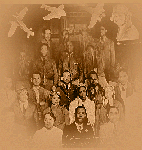 |
- In
1921, Bessie Coleman became the first African-American (man or woman)
to earn a pilot's license. She went to France to get her license. She
was known as "Brave Bessie" during her barnstorming days, and she flew
in air shows to raise money for an aviation school for blacks. http://www.letsfindout.com/subjects/aviation/rfibessi.html
|
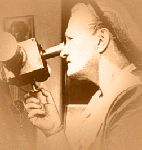 |
- In 1925, Cecilia
Payne Gaposchkin was the first person to earn a Ph.D. in astronomy from
Radcliffe and Harvard. She discovered the chemical composition of stars
and, in particular, that hydrogen and helium are the most abundant elements
in stars and, therefore, in the universe. Though she completed her studies,
Cambridge did not grant women degrees at that time. In 1922, Harvard
College Observatory began a graduate program in astronomy and a fellowship
to encourage women to study at the Observatory. In 1925, she became
the first person awarded a doctorate from Harvard College Observatory.
Her work, however, remained unofficial and unacknowledged until 1938
when she was granted the title of astronomer. She was the first female
to become a full professor at Harvard and she chaired the Department
of Astronomy from 1956-1960. Through her example and struggle against
sex discrimination, she helped forge a path for other women scientists.
http://www.physics.ucla.edu/~cwp/nblimages/gaposa1.1.gif
http://cannon.sfsu.edu/~gmarcy/cswa/history/cecilia.jpeg
|
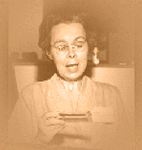 |
- In 1926, Katharine
Burr Blodgett, earned a Ph.D. from Cambridge, and researched molecular
coatings on surfaces. Today, this is an entire field of study and is
important in physics and applied physics, chemistry, surface science,
biology, and medicine. The use of films on surfaces to reflect rays
started the entire field of optical coatings, which now are used universally
on eyeglasses, camera lenses, TVs, and computer monitors. She also made
many important contributions to war research including inventing poison
gas absorbents, de-icing aircraft wings, and improving smokescreens.
http://www.physics.ucla.edu/~cwp/nblimages/blodgc1.gif
|
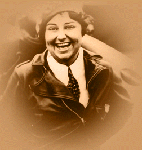 |
- In 1929, Florence
(Pancho) Lowe Barnes became first female stunt pilot in motion pictures,
flying in "Hell's Angels" for Howard Hughes. She went on to set speed
records, form a flying group providing emergency disaster assistance,
and run a popular ranch in Edwards AFB in California. http://www.netsrq.com:80/~dbois/barnes-p.html
|
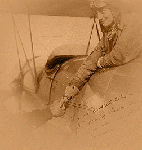 |
- In 1929, the Women's
Air Derby brought the best female pilots together for the first time.
At the time, many people in America did not think women could fly the
distance. Twenty women started out flying from Cleveland and 14 women
finished the race in Cleveland. There were rumors of sabotage. Louise
Thaden won first place.
|
 |
- In 1929, the 99
members of the Ninety-Nines Inc. International, a women's pilot association,
held their first meeting. Fay Gillis Wells hosted that now famous first
meeting and served as the first secretary. In addition to being in aviation,
she was a journalist. From 1930 to 34, she lived in the Soviet Union,
while her father was there working as an engineer, and wrote for the
Herald. She became the first woman to pilot a Soviet civil aircraft.
In 1933, she arranged landing and fuel logistics for the critical Russian
leg of Wiley Post's record solo flight around the world. This allowed
Post to sleep during stops. She continued to further aviation throughout
her career, and she and her husband, Linton Wells, were journalists
living abroad and reporting on battles in Ethiopia, China, and the Soviet
Union.
http://www.si.edu/sites/features/features.htm
http://www.ninety-nines.org/gillis.html
|
| |
- In 1930, Eleanor
Smith was chosen as the best female pilot of the year.
|
| |
- Olive Ann Beech
co-founded Beech Aircraft and worked alongside her husband, Walter,
during the 1930's and 1940's. After his death, she became president
and CEO, and transformed the company into a multimillion-dollar, international
aerospace corporation.
|
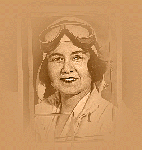 |
- In 1930, Laura
Ingalls set the record for most loops without stopping (980) and the
most barrel rolls (714). In 1935, she also became the first woman to
fly non-stop from New York to California.
|
 |
- In 1931, Anne Morrow
Lindbergh received her private pilot's license. She received the U.S.
Flag Association's Cross of Honor and the National Geographic Society's
Hubbard Medal. Ms. Lindbergh was the first female glider pilot and the
first female navigator who, with her husband, flew the world mapping
transcontinental air routes for commercial aviation. Their pioneering
routes, such as flying north to Newfoundland to reach Europe, are used
today. In 1934, she became the first woman to receive the National Geographic
Society Hubbard Gold Medal for her piloting and navigational skills.
Ms. Lindbergh, who has authored numerous books, began to receive recognition
for her writing while she was at Smith College.
http://www.greatwomen.org/lndbrgh.gif
|
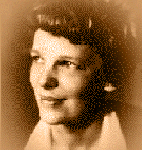 |
- In 1932, Amelia
Earhart became the first woman to make a transatlantic solo flight.
Her father paid for her first flight and she worked odd jobs in California
to pay for the additional training. George Putnam, a publisher of books
about expeditions such as Byrd and Lindberg, began a publicity campaign
and was looking for a woman to make the first transatlantic flight.
She was reportedly chosen because she resembled Lindberg. She continued
to fly, lecture, and participate in air shows dedicating herself to
promoting women in careers.
http://www.kshs.org/people/AMELIA.HTM
|
| |
- In 1932, Elsa Garnder
attended MIT in aeronautical engineering. She was one of a small number
of women elected to the American Society of Mechanical Engineers.
|
 |
- In 1933, Osa Johnson
and husband, Martin, were the first aerial photographers. They photographed
different regions of Earth including Africa and Mt. Kilamanjaro.
|
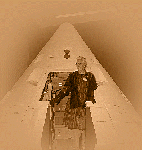 |
- Jeannette Piccard,
Ph.D., earned her science doctorate from the University of Minnesota
and flew stratospheric research balloon flights in 1934. She continued
research and consulted with NASA during the Apollo era.
|
 |
- In 1934, Phoebe
Omlie founded the National Air Marking Program, the first Federal program
directed by a woman. All of her senior staff were women. These pilots
organized the writing of names of towns and cities on barns and buildings,
thereby creating navigational aids. As a young adult in St. Paul, MN,
she went for an airplane ride and so loved the ride that she bought
the plane for $3,500 using her grandfather's inheritance. She performed
in parachute and acrobatics acts, then later she and her husband formed
an aerial circus team.
|
 |
- In 1936, Louise
Thaden was the first woman to win the transcontinental Bendix Trophy
race. This was the first race open to men and women
|
| |
- On July 2, 1937,
Amelia Earhart disappeared during her around-the-world flight.
|
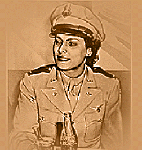 |
- In 1937, Willa
B. Brown, became the first African-American woman to get a commercial
pilot's license. She earned a masters degree from Northwestern University.
She co-founded the National Airmen's Association of America to promote
African-American aviation and opened the Coffey School of Aeronautics.
Approximately two hundred pilots were trained there, some of whom became
part of the "Tuskegee Airmen."
http://media.nara.gov/media/images/43/2/43-0198t.gif
http://www.netsrq.com:80/~dbois/brown-wb.html
|
| |
|















